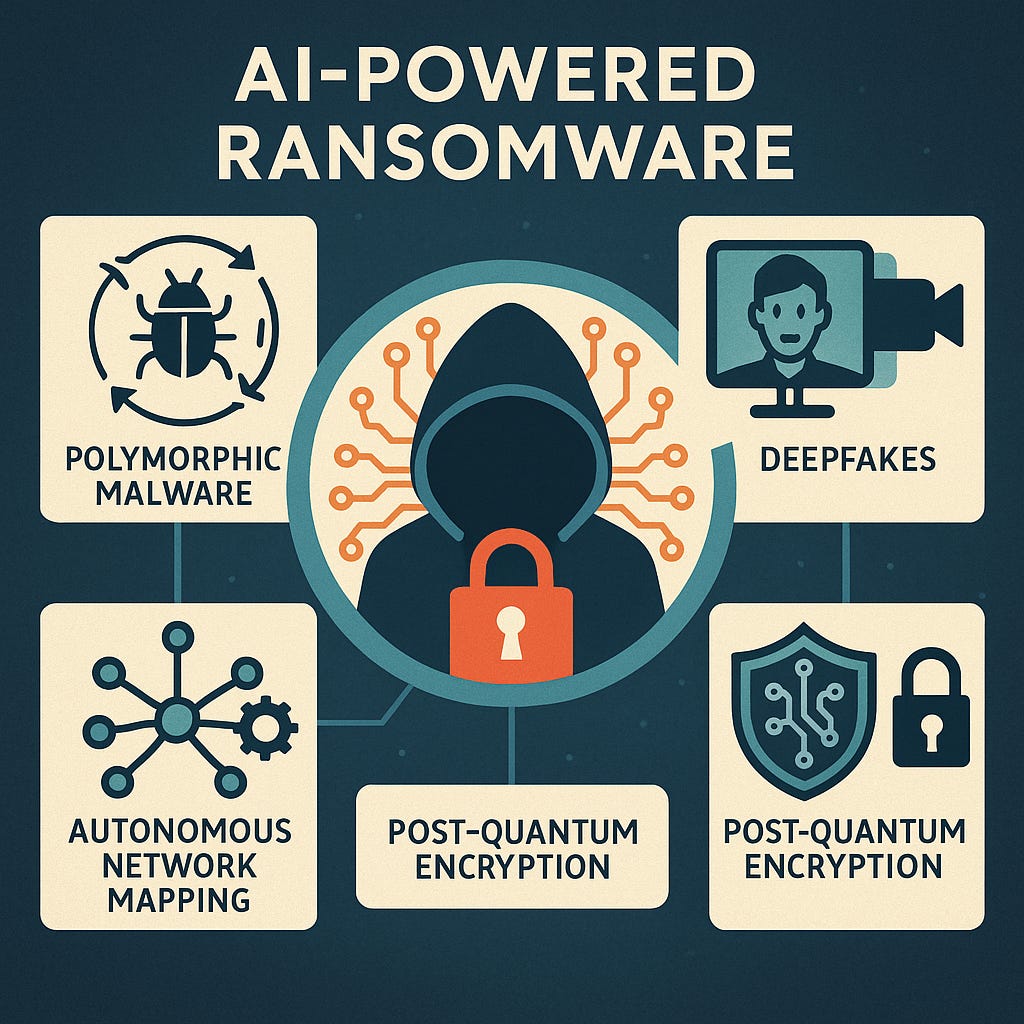What Is Reinforcement Learning as a Service?
What Is Reinforcement Learning as a Service?
AI is a powerful tool for innovation and, increasingly, for crime. As cyber warfare becomes more sophisticated, attacks are becoming more targeted, autonomous, and harder to stop. In this issue, we break down how AI is reshaping the ransomware threat, what RLaaS really means, and who’s leading the charge. Plus, what is “vibe working” but will it work for you or take your work? Let’s dive in and stay curious.
What Is Reinforcement Learning as a Service?
AI Tools - Reinforcement learning
Now we have Vibe working? But what is it?
AI Guides
This Is How AI Is Rewriting the Rules of Cyber Warfare
📰 AI News and Trends
OpenAI takes on Google, Amazon with new agentic shopping system
California Governor Newsom signs landmark AI safety bill SB 53
Anthropic launches Claude Sonnet 4.5, its best AI model for coding
OpenAI’s first-half revenue rises 16% to about $4.3 billion
Jensen Huang says China is ‘nanoseconds behind’ the US in chipmaking, calls for reducing US export restrictions on Nvidia’s AI chips
China’s DeepSeek just launched V3.2-exp, an open-weight model built on a new “sparse attention” design. By layering a “lightning indexer” with fine-grained token selection, it trims the compute load of long-context inference. Early tests claim API calls run at half the usual cost, with the weights already live on Hugging Face for third-party audits.
The creator of AI actress “Tilly Norwood,” who exploded across the internet over the weekend, has insisted she is an artwork, after a fierce backlash from the creative community.
What Is Reinforcement Learning as a Service?
It’s an emerging model where companies offer plug-and-play reinforcement learning tools that allow businesses to train AI systems on real-world behavior, not just data.
Instead of just feeding AI static documents, RL lets you train it by showing it how humans actually do tasks, like drafting contracts, processing invoices, or writing code. The AI gets rewarded for doing it right, and penalized for errors, just like training a dog, but at internet scale.
Why RLaaS Is Taking Off
Traditional AI is plateauing. Pretraining on scraped web data is no longer enough to improve performance.
Businesses want automation. RLaaS lets them train AI agents that mimic expert workflows and complete full tasks, not just generate text.
Cheaper than building in-house. RLaaS platforms provide the algorithms, infrastructure, and tooling without needing deep ML teams.
Who’s Building RLaaS?
Use Cases in the Wild
Law firms: Train AI to review and revise contracts
Finance: Automate document analysis and audit tasks
Dev teams: Use RL-trained coding agents like Devin (by Cognition AI)
Media: RL agents trained to generate and edit videos
What we are reading:
Career creator for those building a life without a blueprint. Every Monday morning, I send out First Things First, a weekly guide to staying present, productive, and purposeful.
Discover how to differentiate your firm. Get our “7 Positioning Sins That Cost Consultancy Firms Millions“ guide when you join. It’s free, join 10,000+ consultancy executives
Now we have Vibe working? But what is it?
Vibe coding has taken the world by storm, and the models available are quite impressive. Anyone can seem to be able to vibe code an app into existence, and engineers are supercharging their output thanks to it. Now, Microsoft is launching a new way to work called “vibe working”. Is anyone going to really work anymore? Powered by AI agents inside Word, Excel, and soon PowerPoint. The idea is that you don’t just use the app, you co-create with it.
Think of it like ChatGPT trained on Office and built to do the work, not just help with it. But if it does the work, are we training our digital replacements?
What Is Vibe Working?
“Vibe working” is Microsoft’s term for agent-powered productivity inside Office apps. Using Agent Mode, you can:
Create reports, budgets, and presentations from a simple prompt
Iterate with Copilot like you’re having a conversation
Automate formatting, summaries, charts, and even branding
It’s a new pattern: AI doesn’t just assist—it takes initiative.
How It Works
Excel Agent Mode: Prompts like “build a loan calculator” or “generate a budget tracker” trigger Copilot to create fully functional spreadsheets with charts, formulas, and formatting.
Word Vibe Writing: Prompt with goals (“clean this up”, “summarize meeting notes”), and Copilot refines the doc, asks clarifying questions, and makes it share-ready.
Office Agent (Copilot Chat): Use natural language to request a presentation or document—Copilot does the research, asks questions, and builds the file from scratch.
All of this is built using Anthropic’s Claude models, not just GPT.
Why It Matters
True agentic productivity: You go from typing in a doc to delegating tasks to an AI.
Better iteration loops: You can now ask, fix, and reframe documents in one place.
Accessible automation: Vibe working simplifies complex tools like Excel for non-experts.
Who Can Use It?
Available on the web version of Word and Excel (PowerPoint coming soon)
Requires Microsoft 365 Personal, Family, or Frontier Program access
Agent Mode in Excel needs the Excel Labs add-in
🧰 AI Tools of The Day
Reinforcement learning
1. Ray RLlib - An open-source library for scalable reinforcement learning from Anyscale. Supports distributed training and is used by companies like Amazon and Uber for custom RL workflows.
2. SageMaker RL - Amazon’s fully managed service to build, train, and deploy RL models in the cloud. Supports simulators like Unity and RoboMaker for training environments.
3. Stable-Baselines3 - A lightweight Python library for building custom RL agents using proven algorithms like PPO, DQN, and A2C. Great for research and early-stage prototypes.
4. Applied Compute - RL-as-a-service startup by ex-OpenAI staffers. Helps enterprises fine-tune AI agents on legal, finance, and dev tasks using reinforcement learning. Currently in stealth but backed by Benchmark and Lux.
5. CleanRL - A minimal, single-file implementation of key RL algorithms—perfect for understanding how RL works under the hood. Great for startups and solo devs.
Download our list of 1000+ Tools for free.
This Is How AI Is Rewriting the Rules of Cyber Warfare
Ransomware in 2025 has evolved into an AI-powered, highly adaptive threat, using polymorphic malware, deepfakes of executives, and autonomous network mapping to strike with speed and precision. No longer just about data theft, these attacks target control and systemic disruption, threatening healthcare, energy, and critical infrastructure. With quantum computing on the horizon, the risk of “harvest now, decrypt later” makes post-quantum encryption urgent. Defenders must adopt behavioral AI, zero-trust policies, offline backups, and deepfake readiness to keep pace. This isn’t just a cyber risk—it’s a strategic battlefield.
🧰 AI Guides
Deep Reinforcement Learning
Hugging Face Deep RL Course
Free, open-source, beginner → advanced track
Hands-on training with RL libraries like Stable Baselines3, CleanRL, etc.
Mixes theory and practice (algorithms, environments, agent training)
Bonus resource: OpenAI “Spinning Up in Deep RL”
It’s a practical RL primer with code, theory, and guidance for how to begin experiments.
Explore our AI Guides — from coding to photography and beyond, find step-by-step tips to put AI to work for you.




